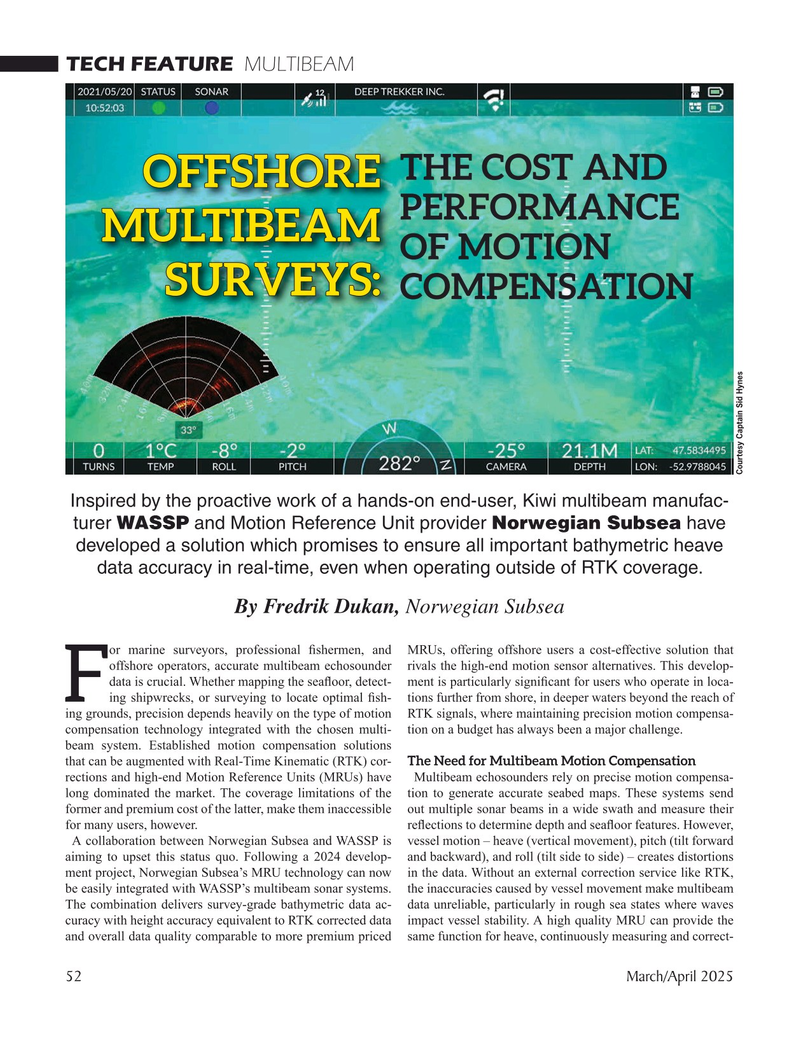
Page 52: of Marine Technology Magazine (March 2025)
Read this page in Pdf, Flash or Html5 edition of March 2025 Marine Technology Magazine
TECH FEATURE MULTIBEAM
THE COST AND
OFFSHORE
PERFORMANCE
MULTIBEAM
OF MOTION
SURVEYS:
COMPENSATION
Courtesy Captain Sid Hynes
Inspired by the proactive work of a hands-on end-user, Kiwi multibeam manufac- turer WASSP and Motion Reference Unit provider Norwegian Subsea have developed a solution which promises to ensure all important bathymetric heave data accuracy in real-time, even when operating outside of RTK coverage.
By Fredrik Dukan, Norwegian Subsea or marine surveyors, professional ? shermen, and MRUs, offering offshore users a cost-effective solution that offshore operators, accurate multibeam echosounder rivals the high-end motion sensor alternatives. This develop- data is crucial. Whether mapping the sea? oor, detect- ment is particularly signi? cant for users who operate in loca-
Fing shipwrecks, or surveying to locate optimal ? sh- tions further from shore, in deeper waters beyond the reach of ing grounds, precision depends heavily on the type of motion RTK signals, where maintaining precision motion compensa- compensation technology integrated with the chosen multi- tion on a budget has always been a major challenge.
beam system. Established motion compensation solutions that can be augmented with Real-Time Kinematic (RTK) cor- The Need for Multibeam Motion Compensation rections and high-end Motion Reference Units (MRUs) have Multibeam echosounders rely on precise motion compensa- long dominated the market. The coverage limitations of the tion to generate accurate seabed maps. These systems send former and premium cost of the latter, make them inaccessible out multiple sonar beams in a wide swath and measure their for many users, however. re? ections to determine depth and sea? oor features. However,
A collaboration between Norwegian Subsea and WASSP is vessel motion – heave (vertical movement), pitch (tilt forward aiming to upset this status quo. Following a 2024 develop- and backward), and roll (tilt side to side) – creates distortions ment project, Norwegian Subsea’s MRU technology can now in the data. Without an external correction service like RTK, be easily integrated with WASSP’s multibeam sonar systems. the inaccuracies caused by vessel movement make multibeam
The combination delivers survey-grade bathymetric data ac- data unreliable, particularly in rough sea states where waves curacy with height accuracy equivalent to RTK corrected data impact vessel stability. A high quality MRU can provide the and overall data quality comparable to more premium priced same function for heave, continuously measuring and correct- 52 March/April 2025
MTR #3 (50-63).indd 52 3/14/2025 10:19:09 AM

 51
51

 53
53
